Little-Known Facts about Carrots that Will Make You Go “What’s Up Doc?”
Did you know that ancient Romans and Greeks ate carrots, but not the orange varieties we know today? They ate wild varieties of various other colors, such as purple, red, white, and yellow.
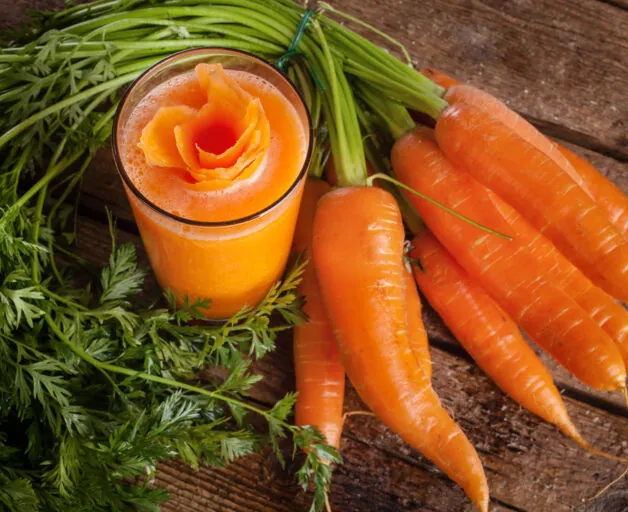
In the 17th century, orange carrots as we know them, first appeared in the Netherlands. Dutch farmers invented the orange carrot in honor of the “House of Orange”, the Dutch Royal Family. The orange color results from beta-carotene, which is a red-orange pigment found in some plants and fruits.
Carrots contain quite the nutritious punch. The most widely known health benefit of carrots is that they contribute to good vision. This is because our bodies turn beta-carotene into vitamin A, which is important for the health of vision (including night vision), and carrots are one of the best sources for beta-carotene. The vitamin A is also important to the health of our bones, skin, and teeth.
Carrots are known to have many medicinal properties. Eating carrots can aid the body in repairing damaged cells. They also can be used as an antiseptic for skin wounds, and very effectively clean your mouth from bacteria.
Other little-known facts about carrots include:
- Just a handful of baby carrots or one medium carrot counts as one serving of your daily veggies.
- Carrots are a good source of fiber, which means they are good for the digestive system.
- Vitamin C, potassium, folate, and vitamin B6 are also found in carrots, as well as several minerals like magnesium and calcium.
- The purple pigments of the purple carrots are called anthocyanins. Anthocyanins act as anti-oxidants that protect the body.
- Including carrots in your diet when breast feeding helps to improve breast milk production.
- A carrot is 87% water, so consuming them can help you to be sure your body is getting an adequate amount of H2O.
- Out of all vegetables, it’s no surprise that carrots have the largest content of vitamin A (beta carotene). 100 grams of carrot will give you 104% of the recommended daily dose.
- 30% of American Vitamin A intake comes from carrots.
- One glass of milk contains the same amount of calcium as in 9 carrots.
- One carrot gives you the energy to walk one mile!
As you can see it is very beneficial to make sure carrots are a part of our diets. However, it is true that eating massive amounts of carrots can sometimes cause a person’s skin to turn yellowish orange. This is a condition called carotenemia and is most noticeable on the soles of your feet or the palms of your hands. It requires an extremely high amount of carrot consumption to get carotenemia, so it is not very common, and it is completely reversible by just reducing carrot intake.
Carrots can be eaten in various different ways. You can eat them raw, they are delicious dipped in hummus or ranch. Carrots are often boiled, baked, fried, grated, juiced, mashed, pulped, pureed, and steamed. Carrots are also often used in stir-fries and salads. They can also be dehydrated to make chips, powder, and flakes. Even the carrots greens are edible, but consumption is rare.
In western countries, the natural sweetness and sugars of carrots allow them to be used in decadent desserts like carrot cake. Portugal is known to use carrots in jam, and in India they are used in many deserts. Around the world carrot juice is widely consumed, especially as a health drink, with or without other fruits and vegetables. You can try them in one of the several recipes that we have collected here on FillYourPlate.org.
In 2004, carrots were ranked as the seventh most valuable crop grown in the United States. California is our top fresh carrot producer, and Washington is the top grower of carrots meant for canning and processing. However, Arizona carrot production is nothing to sneeze at. The Rousseau Family Farms is our largest carrot farmer producing on average 42,000,000 pounds of carrots each year which are then sold to grocers all over the United States (including Arizona). The average American eats around 10.6 lbs. of fresh carrots a year, so the carrots grown at Rousseau Family Farms alone can feed around 3,962,264 people in a year!
There really are quite a bit of carrot facts. Here are some more!
- Mel Blanc (the voice of Bugs Bunny) was allergic to carrots!
- Baby carrots aren’t actually babies. A baby carrot comes from a large carrot that was rolled over blades and thrown around in a metal cage to be rubbed down into a round-ended, short baby carrot.
- Out of all of the vegetables, only the beet contains more natural sugars than carrots.
- One teaspoon can hold 2000 carrot seeds.
- In 17th century England, carrot leaves were often carried in the hair as a fashion statement.
- Carrots were first introduced to America in 1607 with the first settlers who landed in Jamestown, however they did not become a very popular food until soldiers returned from WWI after having constant contact with them.
- Wild rabbits don’t eat wild carrots.
- The heaviest carrot recorded weighed 18.985 lbs.
- The longest carrot recorded was nearly 17 feet long.
Rousseau Family Farms, though our largest carrot producer, is not the only place you can go to enjoy locally grown carrots. When you visit Fill Your Plate, you can click on “Find a Farm Product” and type in carrots, and a list of local growers will pop up. You can then choose a grower closest to you. You can also buy fresh Arizona-grown carrots from Rousseau Family Farms, most likely, at your local grocery store.
Related articles
- Fun Facts About Zucchini (fillyourplate.org)
- A Simple Guide to Start Eating Healthier (fillyourplate.org)
- Fun Facts about Clementines (fillyourplate.org)
Simple, Thoughtful Recipes Work Best for Holiday Feasts
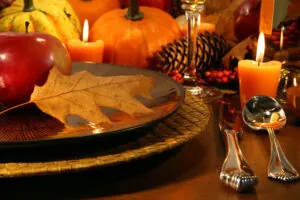
Thanksgiving is right around the corner and if you are like us, you are spending your evenings searching Pinterest for the perfect recipes to make your meal a masterpiece. Despite the fact that last year didn’t turn out the way you planned (or maybe because it didn’t), you are determined to have a holiday happening that could grace the pages of Martha Stewart’s magazine. With the big day still weeks away, the stress and panic often brought on by actually making that masterpiece has yet to set in and it is easy to forget how crazy we make ourselves simply by trying to do too much and by making things a lot harder than they need to be.
So, instead of spending your evenings looking for the most complicated dishes and dreaming of desserts that would be considered divine in a 4 star restaurant, stop the madness before it starts and settle on a simple approach to your holiday meal.
Why Simple is Better
When you are the one making the Thanksgiving meal it is easy to feel a lot of pressure to make it perfect. Whether you need to show up your sister who seems to channel Martha Stewart or you are looking to impress your future spouse and in-laws, the tendency is to take on too much. Instead of making the standard sides, we choose complicated recipes and offer too many options. Rather than using the pre-made pie crust from the store, we decide to make everything from scratch. And while our intentions are good, the outcome often isn’t. Rather than making a delicious hearty feast that is simple enough to allow us to spend time with our loved ones, we reach for the stars and end up frustrated and stressed.
Taking a Thoughtful Approach
Settling on simplicity doesn’t mean you need to sacrifice taste, flavor, or quality and it doesn’t mean you can only serve turkey, potatoes, and pie. It means taking a thoughtful approach to planning your meal that takes into account your skills, the time you have available, and the likes and dislikes of the people who will be joining you for dinner. For example, providing a vegetarian dessert option for your cousin’s vegetarian family shows you care more than any 9 course meal even could.
Simple Doesn’t Have to Mean Standard
Deciding to take a simple approach doesn’t mean serving up a standard Thanksgiving meal devoid of any flare or interesting flavors. In fact, choosing non-standard dishes might actually make things simpler. For example, you might choose to skip the whole ‘roasting a full turkey in the oven’ thing and opt for a much simpler turkey dish instead. To help you start planning, here are some simple, yet delicious ideas for Thanksgiving dishes courtesy of the Fill Your Plate recipe section.
Turkey
Cranberry Sauce
Rolls and Breads
Sides
- Dru’s Special Holiday Stuffing
- Orange Coated Yams
- Stuffed Pumpkin
- Roasted Red Potatoes and Asparagus
- Balsamic Green Beans with Pine Nuts
Desserts
Related articles
- 5 Things You Can do in Your Kitchen to Make Cooking Easier (fillyourplate.org)
- It’s Thanksgivikkuh?! (fillyourplate.org)
- How to Host a Chili Cookoff (fillyourplate.org)
50 Ways to Use Pears
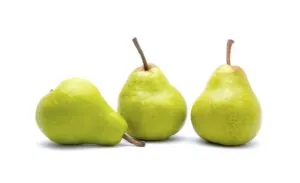
Pears belong to the same family as many other fruits like apples, cherries, peaches and plums. Most pears sold in the U.S. have a specific ‘pear’ shape, with a round body that tapers up to a thinner, longer neck. Pears can be green, red, gold, yellow, and brown. Unlike other fruits, most types of pear do not change color as they ripen which can make it challenging to determine when they are ripe and when they are not.
To help you become better acquainted with this tasty fruit, here are the varieties you are most likely to encounter in the store.
Bartlett
If you are eating a pear, it is very likely a Bartlett pear. These yellow and green pears are the best known and most common type of pear in the U.S. They are also the pear generally used in canned pears.
Bosc
Although not as popular as the Bartlett, the Bosc pear is also well-known. It has a cinnamon brown skin and a flavor reminiscent of honey.
Anjou
Also well known, Anjou pears can be red or green. They have a shorter neck that other kinds of pear and often show up in sweet desserts.
Celebrate the sweetness of pears this month with these fantastic recipes.
- Apple Pear Salad
- Beet and Pear Puree
- Vanilla Poached Pears
- Pear Sauce
- Pear and Gorgonzola Pizza
- Farmer’s Favorite Salad
- Gingered Pears and Parsnips
- Curried Butternut Squash and Pear Soup
- Pear and Fennel Salad
- Pear Bread
- Orange Cranberry Pear Relish
- Blue Cheese and Pear Tartlets
- Roasted Baby Pears with Herbed Goat Cheese
- Pear Honey Cranberry Sauce
- Celery Root and Pear Puree
- Roasted Pears with Caramel Sauce
- Bacon and Pear Bites
- Spiced Pear and Pomegranate
- Spiced Pear Upside Down Cake
- Prosciutto, Caramelized Pears, and Walnut Salad
- Pear Crisp
- Balsamic Pear, Chicken, and Asparagus
- Pear Spice Twists
- Arugula and Pear Salad
- Pear and Almond French Toast Casserole
- Roasted Pears with Bleu Cheese
- Maple Pears
- Fall Salad with Cranberry Vinaigrette
- Pear Ginger Crumble
- Cranberry Pecan Pear Pie
- Autumn Fruit Tarts
- Chicken Fried Pork Chops with Pear Chutney
- Pecan Pear Torte
- Gorgonzola Pear Pasta
- Almond Pear Torte
- Cinnamon Pear Frozen Yogurt
- Baked Pork Chops with Sweet Potatoes and Pears
- Pork Roast with Pears and Rosemary
- Spiced Pear and Apple Pie
- Winter Bread Pudding with Dried Pears
- Pear Risotto with Prosciutto and Fried Sage Leaves
- Ham and Pear Panini
- Pork Medallions with Pears and Spaghetti Squash
- Pear and Ginger Cheesecake
- Sweet Potatoes with Pears
- Pear and Fig Green Salad
- Chicken Thighs with Pear Leek Sauce
- Spinach, Pear, and Feta Salad
- Roasted Chicken with Bourbon Pear Butter Glaze
- Pear Bleu Cheese Flatbread
Related articles
- 50 Fantastic Ways to Use Figs (fillyourplate.org)
- 50 Things to Do With Peas (fillyourplate.org)
- 31 Ways to Fill Your Plate with Arizona Eats (fillyourplate.org)
Get Passionate about Pineapple!!
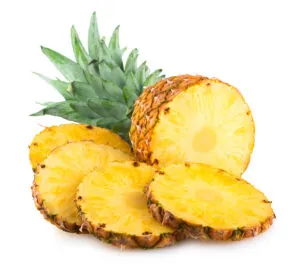
When you think of pineapple, you probably think of somewhere tropical like Hawaii, not the dry desert climate of Arizona. But our climate is almost ideal for October’s sweet, juicy fruit of the month. The sunny color and summertime taste of pineapple can brighten even the bleakest fall day. To help you get as passionate about pineapple as we are at Fill Your Plate, here are some fun facts, helpful tips, and creative ways to use pineapple at every meal.
Historically Speaking
Pineapples are native to the Caribbean and South America. When Christopher Columbus came to the New World in 1492-93, he experienced his first pineapple on one of the Caribbean Islands. In colonial times, pineapples, like other exotic fruit, were seen as a luxury because of the time and expense required to import them from Central America.
The Sum of Its Parts
Although we think of a pineapple as a single fruit, it is actually created by the joining of many different fruitlets around a single core. Pineapples provide a good source of vitamin C and are believed to help support your body’s immune system and help relieve inflammation. An average cup of pineapple has 75 calories.
Choosing and Caring for Your Pineapple
When picking a pineapple, avoid any that are bruised or visibly damaged. Once you find one that looks good, hold it up to your nose and breathe in, if it smells sour at all, choose a different one. When you get it home, let it sit on the counter for one or two days to get the softest, juiciest result.
The best way to cut your pineapple is to start by slicing off the top and bottom with a sharp knife. Stand the pineapple up on the newly flat bottom and slice downward to remove the skin. Next, slice the fleshy fruit away from the core and discard the core. Cut the remaining fruit into chunks or slices.
How to Use It
Pineapple is great as a snack any time of day but it can also be a sweet addition to any meal. Here are some ways you can get more pineapple on your plate.
Breakfast
- Mango, Strawberry, and Pineapple Smoothie
- Pineapple Muffins
- Coconut French Toast with Grilled Pineapple
- Pineapple Breakfast Casserole
- Pineapple Cheesecake Danish
Salads
- Wheat Farmer’s Salad
- Aloha Coleslaw
- Pistachio Salad
- Tropical Salad with Pineapple Vinaigrette
- Perfect Fruit Salad
Main Dishes
- Pork Kabobs
- BBQ Pork with Grilled Pineapple Relish
- Seared Mahi Mahi with Grilled Mango Pineapple Salsa
- Sweet and Sour Pineapple Pork
- Chicken and Pineapple Skewers
Side Dishes
- Pineapple Fried Rice
- Pineapple Stuffing
- Pineapple Sweet Potatoes
- Carrot Pineapple Slaw
- Golden Pineapple Casserole
Desserts
- Pineapple Upside-Down Cake
- Pineapple Angel Food Cake
- Banana Split Cheesecake
- Pineapple Crisp
- Pineapple Orange Sorbet
Related articles
- Are Sweet Cherries the New Superfruit? (fillyourplate.org)
- What to Do With All That Fruit? (fillyourplate.org)
- 10 Ways to Fill Your Day with Fruits and Vegetables (fillyourplate.org)
Ingredients that Matter When We Have a Snack Attack
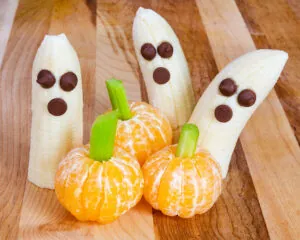
People all around the world love to snack which is apparent when looking at the results of Nielsen’s Global Survey of Snacking. This $374 billion industry just keeps growing and it isn’t the biggest snackers on the planet, Americans and Europeans, driving most of that growth. While the total year over year increase in money spent on snacks increased by 2% globally, it was the up and coming snackers in regions like Latin America, Asia-Pacific, and the Middle-East (9%, 5%, and 4% respectively) that helped fuel the increase.
When it comes to what kind of snacks we like, there are two main drivers, taste, which is obvious, and health considerations, which isn’t. In fact, the survey showed that these two are almost equal in importance and that when it comes to choosing the snack we want; we aren’t really interested in compromising.
Although many people might think of ‘sweets’ when they hear ‘snacks’, the savory snack category is actually growing faster than any other category. These are the snacks that we most often use to replace a regular meal which is one reason this category is growing so fast. Things like crackers, rice cakes, meat jerky, yogurt, and cheese are all experiencing the fastest-growth in almost every region.
This underscores one of the key findings of the survey – when it comes to snacking, consumers are focused on how those snacks can help or hurt their health. Traditional sweet snacks like cookies and confections still reign supreme when it comes to snack sales but as the focus shifts more and more to snacking healthy, it is the snacks that are seen as ‘healthy’ that are driving sales and growth.
When it comes to how we choose our healthy snacks or how we decide if a snack is healthy or not, ingredients matter. What our snacks contain or what they do not contain is one of the most important factors we consider when choosing a healthy snack. When asked to rank 20 different attributes that are important when choosing a healthy snack almost half of those who participated in the survey put snacks with all natural ingredients at the top of the list. We also want snacks that are high in fiber and protein and those that are made with whole grains.
What is not in our snacks is almost as important as what is when it comes to what we choose. The demand for specialty snacks like those that do not contain caffeine or that are gluten-free are also seeing an increase in demand. Demand for snacks that are low in sugar, salt, fat, carbohydrates, and calories is also increasing as the focus shifts from sugary sweet snacks to healthy snacks. Other key factors included the lack of artificial colors, genetically modified organisms, and artificial flavors.
The survey collected information from more than 30,000 consumers from more than 60 countries in their online campaign. Participants were asked to provide information on which attributes affected their snack selections in categories like health, taste, and texture. For more information about the survey, visit Nielsen’s website.
Fill Your Plate has a great mix of recipes including desserts that might satisfy that snack attack urge in you.
Related articles
- Top 5 Healthy Snacks for Back to School (fillyourplate.org)
- Are Your Kids Eating Right? (fillyourplate.org)
- B is for Breakfast (fillyourplate.org)
It’s National Cheesecake Day!

National Cheesecake Day, which is unofficially celebrated on July 30, is your chance to celebrate this deliciously dreamy dessert featuring soft creamy cheese. Join other cheesecake lovers around the country to celebrate one of America’s favorite desserts. Whether you like it plain, covered with fruit, swirled with chocolate, or filled with exotic flavors, don’t miss out on the one day a year this creamy dessert is the star of the show. To help you celebrate, here are some ideas for making National Cheesecake Day a fun event for your family and friends and some great recipe ideas for time-tested traditional cheesecake and fancy foodie cheesecake.
1. Have a Contest to See Who Makes the Best Cheesecake on the Block
National Cheesecake Day provides a great opportunity to get friends, family, and neighbors together for some quality time and some fantastic cheesecake. Ask everyone to bake or make their favorite cheesecake and then have a blind taste test where everyone gets to vote on their favorite entries. Offering prizes like “Creamiest”, “Most Unusual”, “Most Like My Mom’s” lets more people win and spreads the fun around.
2. Have a Cheesecake Raffle for Charity
Ask friends and family to donate cheesecakes, homemade or store bought, and then set up a table at a local church, community center, or community event and raffle off the cheesecakes. Just remember to plan ahead for a way to keep those cheesecakes that need to be refrigerated cold. You might take pictures of each cheesecake so that potential raffle ticket buyers can see what they are trying to win without risking any spoilage. You could also keep the cheesecakes safely stored in a refrigerator until it is time to start raffling them off.
Raise money by selling entries to a drawing to be held at the event or later in the day. When it comes time to draw the winners, start drawing names and let each person pick the cheesecake they want when their name is called. You will need to decide up front if people must be present in order to win. If not, make sure you know how you will handle choosing, storing, and delivering cheesecakes to winners who are not there at the time of the drawing.
3. Make a Special Treat for those Who Need it Most
Another great way to celebrate National Cheesecake Day is to work with a local homeless shelter or food bank to see if you can donate enough cheesecake for all of their recipients to have a slice with their dinner that day. Then ask friends and family to donate cheesecake and even come with you to help serve up this special treat on National Cheesecake Day.
4. Use Fresh Arizona Ingredients
If you are looking for a great way to celebration National Cheesecake Day in true Arizona fashion, try these recipes that feature fresh Arizona ingredients from the local farmers market.
Related articles
- Say Cheese! It’s National Cheesecake Day! (fillyourplate.org)
- Say Cheese…..Its National Cheesecake Day! (fillyourplate.org)
- Delicious Ways to Use Arizona Dairy (fillyourplate.org)
Fantastic Ways to Feast on Arizona Food this Month

When you think of May holidays, images of Mother’s Day Brunches and Memorial Day BBQs are likely to form in your mind, but don’t limit your celebration to these two days. May is jam-packed with fun food holidays that offer some great opportunities to partake in the spring bounty provided by the farmers and ranchers of Arizona’s agriculture industry.
Here are all the fun food holidays this month and some ideas on how to celebrate using locally grown and raised food products.
National Asparagus Month – Oven Roasted Red Potatoes and Asparagus
National Barbecue Month – Sonoran Hamburgers and Sonoran Hot Dogs
National Egg Month – Arizona Quiche
National Hamburger Month – Buckboard Bacon Burger
National Salad Month – The Farmer’s Favorite Salad
National Salsa Month – Corn and Black Bean Salsa
National Strawberry Month – Strawberry Shortcake
Here are some food holidays by date along with their recipe for ideas to feast on Arizona food this month!
May 1: National Chocolate Parfait Day – Chocolate Parfait
May 2: National Truffles Day – Chocolate Truffles
May 3: National Raspberry Tart Day – Raspberry Tart
May 4: National Orange Juice Day – Apricot Appetizer
May 5: National Chocolate Custard Day – Triple Chocolate Custard Recipe
May 6: National Crêpes Suzette Day – Crepes Suzette
May 7: National Roast Leg of Lamb Day – Basque Barbecue Leg of Lamb
May 8: National Empanada Day – Beef Empanadas
May 9: National Butterscotch Brownie Day – Chewy Butterscotch Brownies
May 10: National Shrimp Day – Shrimp Ceviche
May 11: Eat What You Want Day – Juiciest Hamburger Ever
May 12: National Nutty Fudge Day – Chocolate Peanut Butter Fudge
May 13 National Apple Pie Day – Apple Raspberry Pie
May 14: National Buttermilk Biscuit Day – Buttermilk Biscuits
May 15: National Chocolate Chip Cookie Day – Nestle Tollhouse Chocolate Chip Cookies
May 16: National Coquilles St. Jacques Day – Coquilles St. Jacques
May 17: National Cherry Cobbler Day – Cherry Cobbler
May 18: National Cheese Soufflé Day – Cheese Soufflé
May 19: National Devil’s Food Cake Day – Devil’s Food Cake
May 20: National Quiche Lorraine Day – Quiche Lorraine
May 21: National Strawberries and Cream Day – Strawberry Cream Parfait
May 22: National Vanilla Pudding Day – Homemade Vanilla Pudding
May 23: National Taffy Day – Grandma’s Taffy
May 24: National Escargot Day – Easy Garlic Escargot
May 25: National Brown-Bag-It Day – Brown Bag Lunch Ideas for Grownups
May 26: National Blueberry Cheesecake Day – Ultimate Blueberry Cheesecake
May 27: National Grape Popsicle Day – Make Your Own Popsicles
May 28: National Brisket Day – Braised Beef Brisket
May 29: National Coq Au Vin Day – Classic Coq Au Vin
May 30: National Mint Julep Day – Mint Julep
May 31: National Macaroon Day – French Macaroons
Related articles
- What’s in Season in May? (fillyourplate.org)
- It’s Salsa Month: Let’s Heat Things Up! (fillyourplate.org)
- 50 Creative Ways to Use Carrots (fillyourplate.org)
Get Your Green On to Throw the Perfect St. Patrick’s Day Party
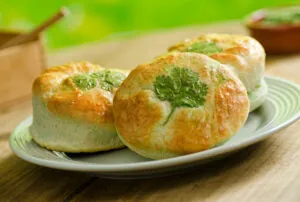
St. Patrick’s Day is right around the corner which means it is time to get out your green, find some shamrocks socks, and get ready to celebrate all things Irish. Although St. Patrick’s Day started as a religious holiday more than a millennium ago, today’s celebration is more about drinking Irish drink things, eating green things, and having a great time. This makes it the perfect time to throw a green-themed party. And while not all traditional Irish fare makes great party food, there are many ways to treat your guests to a culinary experience worthy of this raucous holiday.
Here are some great ideas for taking your St. Patty’s Day party beyond green-beer guzzling contests and making it a true celebration of the tastes and flavors of the Emerald Isle. Just remember, it doesn’t matter where you were born or which country your ancestors came from, on St. Patrick’s Day, everyone gets to be Irish.
Appetizers
- Corned beef and cabbage rolls
- Beer Battered Broccoli
- Grilled Tomatoes
- Beer Battered Broccoli
- Irish Grilled Cheese
Main Dishes
- Irish-American Corned Beef Hash
- Corned Beef and Cabbage
- Black and Tan Leg of Lamb
- Beer Braised Corned Beef with Red Potatoes and Carrots
Soups and Stews
Sides
- Boxty Pancakes
- Irish Champ
- Colcannon
- Black and Tan Pork with Spicy Ale Slaw
- Black and Tan Irish Mac n Cheddar
Breads
Beverages
- Irish Hot Chocolate
- Irish Coffee
- Black and Tan
- Green Iced Tea
Desserts
- Toasted Oat and Apple Crumble
- Black and White Pudding
- Black and Tan Sweet Beer Dessert
- Chocolate Guinness Cupcakes
- Chocolate Stout and Irish Cream Cupcakes
- Rum Raisin Rice Pudding
- Boozy Irish Whisky Cake
- Irish Cream Pie
- Green Velvet Cake
Related articles
- Go Green for St. Patrick’s Day (fillyourplate.org)
- Get to Know Your Leafy Greens (fillyourplate.org)
- Everything is Better with Bacon (fillyourplate.org)
Make a Memorable Mardi Gras Meal

You don’t have to take a trip to New Orleans or walk along Bourbon Street to celebrate the spirit of Mardi Gras this year. Turn your home into New Orleans West and invite friends and families over for a fun night of fabulous food. Grab some green and purple party favors and invite everyone to make their own Mardi Gras masks because everyone is sure to be in the spirit with these delicious Cajun dishes made with fresh Arizona ingredients.
- Set the mood from the very beginning by putting out an arrangement of these amazing appetizers for your guests to nibble on as everyone arrives.
- If there is one thing that is synonymous with Cajun cooking, it has to be Gumbo and you just can’t have a proper Mardi Gras meal without serving up some of these great Gumbo recipes.
- It is almost as important to have some spicy Jambalaya on your Mardi Gras menu as it is to have gumbo. Try one or two of these great Jambalaya recipes or make your own version. The basic recipe is to make a roux, add all your favorite stuff plus some rice! You can’t go wrong.
- There are also other delicious Cajun dishes that you can use to fill out your Mardi Gras menu.
- It just wouldn’t be Mardi Gras without dishes filled with traditional desserts decorating the table. Here are some of the ways you can use tasty and traditional Mardi Gras desserts to infuse your meal with the spirit of Mardi Gras
- Don’t forget to feature some of the most famous drinks found along Bourbon Street during Mardi Gras. If you are looking for authenticity, your Mardi Gras meal will miss the mark if you don’t offer up these cool refreshments to your guests.
- The Hurricane – Created by the famous Pat O’Brien’s pub located in the French Quarter, this drink is served in a specially shaped glass that resembles a hurricane lamp. It also packs quick a punch when made properly.
- The Sazerac – A true New Orleans original featuring rye whisky in an absinthe-coated glass
- The Vieux Carre – Full of booze, both sweet and bitter, smooth just like the city it comes from.
Also, don’t miss these two favorite recipes from the Romeros, Arizona’s own Cajun chefs!
Related articles
- Celebrate Mardi Gras Like a Cajun (fillyourplate.org)
- 30 Ways to Use Rice (fillyourplate.org)
- 50 Things to Do With Chicken (fillyourplate.org)
6 Ways Cooking More Can Cost You Less
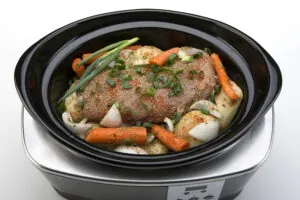
If your family is like many Arizona families, one of your most important resolutions this year is to find ways to get more with less…especially when it comes to filling our plates with nutritious meals. One of the best ways to do that is to cook more of those meals at home. Here are 6 ways cooking can help you shrink your food budget without sacrificing nutrition or taste.
1. Cook Less, Eat More
One great way to save the amount of money and time you spend on each individual meal is to cook more than one meal at a time. Doubling or even tripling a recipe means you can eat two to four meals for the time it takes to make one meal. The best recipes to choose for multiple meals are those that freeze well or that can be made into more than one thing. For example, if you are having tacos tonight, make enough taco meat for tonight’s meal and also to use in chili on another night and to fill enchiladas next week.
2. Use the Crockpot
You might only think of using the crock-pot in the cupboard for potluck parties but it can be a real time and money saving when it comes to making meals at home. It also makes it much easier to make hearty home-cooked meals while you are at work or out of the house. One pot meals like soups and stews cut down on time and money.
3. Leverage Your Leftovers
Leftovers have a bad reputation but if you can find ways to re-use them creatively, they can really help cut your food costs. While most people might look down on leftovers, they can make great lunches. They are also great in multi-ingredient meals like soups, stews, and even stir-fried dishes. Have a few left over pork chops? Chop them up for a spicy Szechuan stir fry. Have some leftover steak sitting in the fridge? Chop it up and make your own steak Caesar salad.
4. Start with a Salad
Everyone needs to eat more vegetables and starting your main meal with a big, flavorful salad can kill two birds with one stone. First, you will be getting more nutritious veggies onto your family’s plate. Second, you will decrease the amount of entrée and sides you need for everyone to get their fill by having them partially fill up on salad first.
5. Do It Yourself Dessert
You don’t have to cut out delicious desserts to cut back on your food bill if you make your own delicacies at home. Homemade pie, cakes, and cookies cost a fraction of those that are pre-made at the store. If you make them from scratch, you can cut costs even more.
6. Buy Big, Serve Small
One easy way to get more food for your money is to buy big and serve small for things that you currently buy in single servings. Yogurt is a great example of how this can save you some real cash. Instead of buying 8 individually packaged single serving yogurt cups, buy one large tub of yogurt and split it into single servings yourself.
Related articles
- Holiday Dining on a Dime (fillyourplate.org)
- 5 Easy Ways to Eat Better for Less (fillyourplate.org)
- Eating Healthy on a Dime (fillyourplate.org)
6 Tips for Beating the Holiday Bulge

The holiday season should be one of the happiest times of the year as we gather together with friends and family to count blessings and celebrate togetherness. Unfortunately, all those gatherings come with a dearth of delicious desserts, tasty treats, and fabulous foods. It’s no wonder so many of us gain more than just gifts. It may feel like you have to stick close to home and avoid the buffet tables, cocktails, and cookies but you don’t have to take such extreme action to make it to New Year’s without adding any pounds. Here are 6 tips for getting through the holiday get-togethers without gaining weight.
1. Browsing is Your Friend
Holiday events are bound to have a buffet and the best way to add a ton of calories to your plate is to grab a plate and dig right in. Instead, take a few minutes to browse the buffet before you even pick up a plate. Pick the things that you want the most and leave the rest alone.
2. Eat Before You Go
One of the best ways to keep yourself from over-indulging is to have a small healthy meal or snack before you leave home. If you approach the buffet table without a grumbling stomach, you are more likely to be picky about what goes on your plate.
3. Pace Yourself
Pacing is also important. You can easily overeat if you are focused solely on getting the most food into your mouth in the shortest amount of time. Instead of eating every plate as if it was your last meal, shift the focus of the event from food to interacting. Then, talk twice as much as you eat and you will be surprised how satisfied you are with a much smaller amount of food.
4. Portion Control is Paramount
Another way that you can easily eat much more than you need is portion size. If there are two sizes of plate available, always take the smaller one. Don’t load up your plate right away, especially if it is a buffet. Eat a small serving of the things that look the most interesting, talk some more, and then if you are still hungry, take more food.
5. Don’t Deprive Yourself
Sometimes our best intentions can be our worst enemy and this is true when it comes to banning certain things from our diet, especially if it is something we crave. Denying yourself that snickerdoodle cookie might seem like the best choice for winning this war but for many of us, the opposite is true. Sometimes, deprivation of a craving leads to eating everything except that one cookie which is much worse than just giving in and eating the cookie.
6. Don’t Forget About Drinking
Unfortunately, food is not the only thing that makes us gain weight during the holiday season which is why we need to keep track of everything that goes in our mouths. This includes eggnog and hot chocolate as well as alcoholic beverages like beer, wine, and cocktails. All of these beverages come with calories and if you aren’t paying attention to them, they can wind up on your thighs as quickly as cake and cookies.
Related articles
- What’s on Your Christmas Dinner Plate? (fillyourplate.org)
- 5 Tips to Make Holiday Cooking Easier (fillyourplate.org)
- Holiday Dining on a Dime (fillyourplate.org)
It’s Thanksgivukkah!?!

In some ways, the pairing of Thanksgiving and Hanukkah is a natural fit. (photo credit: BigStockPhoto.com)
The holiday season is upon us which means Thanksgiving, Hanukkah, and Christmas are right around the corner. While these three events are normally celebrated on different days that spread from November through December, 2013 is a very unusual year and Thanksgiving and the first day of Hanukkah fall on the same day. This is so rare in fact that it won’t happen again for more than 70,000 years! The unusual nature of the coincidence is responsible for a phenomenon that is sweeping across the country, a dual celebration aptly named “Thanksgivukkah”.
In some ways, the pairing of Thanksgiving and Hanukkah is a natural fit. Thanksgiving celebrates the arrival of the first pilgrims who fled England because of religious persecution. Hanukkah is a remembrance of the struggle Jews encountered when the Temple was seized and simply practicing their religion could result in a death penalty. Both holidays commemorate the struggle for religious freedom and the right to live according to your own beliefs. These are ideals that most anyone can get behind, regardless of their faith, which may explain why this unusual occurrence has become a country-wide phenomenon.
Here are some creative ideas for combining the two holidays that will help you make the most of this once in a lifetime occurrence.
Let’s start by looking at what is served at a traditional dinner for each of the holidays.
On Thanksgiving, a traditional dinner includes roasted turkey, stuffing, mashed potatoes, sweet potatoes, cranberry sauce, and several vegetable side dishes. For dessert, pumpkin pie is a seasonal favorite on most Thanksgiving tables. These foods represent the types of food the pilgrims would have found or grown in their settlements.
During Hanukkah, traditional foods center on fried foods and cheese, both of which represent important traditions in the Jewish Faith. A typical Hanukkah meal would feature favorite Jewish dishes like matzo ball soup, brisket, challah bread, and kugel with Hanukkah specific dishes like latkes. Dessert is generally something fried like a donut or beignet.
If you compare the two menus, creating a delicious dinner that combines both traditions is not only possible, but could create some interesting combinations that may become family favorites for years to come. Pick and choose from these recipe ideas or create your own custom Thanksgivukkah dish that combines what your family loves most about both holiday traditions.
Meats
Sides
- Challah Wild Mushroom Herb Stuffing
- Pumpkin Kugel
- Popping Cranberry Sauce
- Horseradish Chive Masked Potatoes
- Sweet Potato Latkes
- Bread Kugel with Dried Fried and Sun-dried Tomatoes
- Balsamic Green Beans with Pine Nuts
- Basil Butter Sweet Potato Patties
- Acorn Squash with Pomegranate Seeds
Breads
Desserts
Crazy for Cupcakes

It seems like these days everyone is crazy for cupcakes! Once relegated to classroom parties and afternoon treats, creative flavors of cupcakes are finding their into wedding cakes and onto the dessert tables at baby showers. No longer just for children, today’s cupcakes are just as likely to feature flavors favored by adults. Whether they are spread out on trays or stacked up into towers, there is no question that when it comes to cupcakes these days there is something for everyone.
History of the Cupcake
Cupcakes as we know them today have only been around about as long as our country. The first recipe for a similar cake appears in a cookbook at the end of the 1700’s but the term cupcake doesn’t show up for another 30 years. Originally, cupcakes were baked individually in small crocks or cups which is where they got their name. The introduction and wide-spread adoption of muffin pans changed the face of cupcakes forever. Rather than baking cakes individually, people could now bake 12 at a time.
Cupcakes are also sometimes called fairy cakes because of their small size and often fanciful icing that makes them seem perfect desserts for fairies. The term “cup cake” can also refer to another kind of cake all together. Unlike cupcakes, these cakes don’t get their name from their size but from the way they were made. These cup cakes were similar in color and texture to modern day pound cake and got their name because the recipes called for the ingredients to be measured by volume, 1 cup of butter, 3 cups of flour, rather than by weight.
Favorite Flavors
Growing up, cupcakes were usually made from yellow, white, or chocolate cake mix. These days, the creative flavors used in the cake, the frosting, and the filling range from sweet to savory and just about everything in between. While chocolate cupcakes are still one of the most common flavors, you might be surprised to see what other flavors are winning the popularity contest.
- Vanilla – While these cupcakes can be white or yellow, their vanilla flavor shines through. Often paired with sweet, traditional cake frosting flavors like butter cream.
- Pumpkin – This flavor is almost as American as apple pie and it seems we simply love it when it is baked into a cupcake. You may have difficulty finding this flavor in any season but fall but you can always make your own.
- Banana – This might be a surprise because banana bread is popular but most people have never heard of banana cake. However, they are one of the rising stars and go great with several different kinds of frosting.
- Peanut Butter – Another flavor that you may never have thought of that is a star in the cupcake world. One of the more savory flavors, this cupcake goes great with a variety of frosting flavors or just a layer of your favorite jelly.
- Red Velvet – Definitely the most decadent and some might say the most delicious, red velvet cupcakes topped with cream cheese icing are just as delicious as their full size family members.
Related articles
- Fix Ahead Food for Your Summer Road Trip (fillyourplate.org)
- 6 Great Ways to Connect With Your Kids This Summer (fillyourplate.org)
- Fabulous Feasts for Family Game Night (fillyourplate.org)



